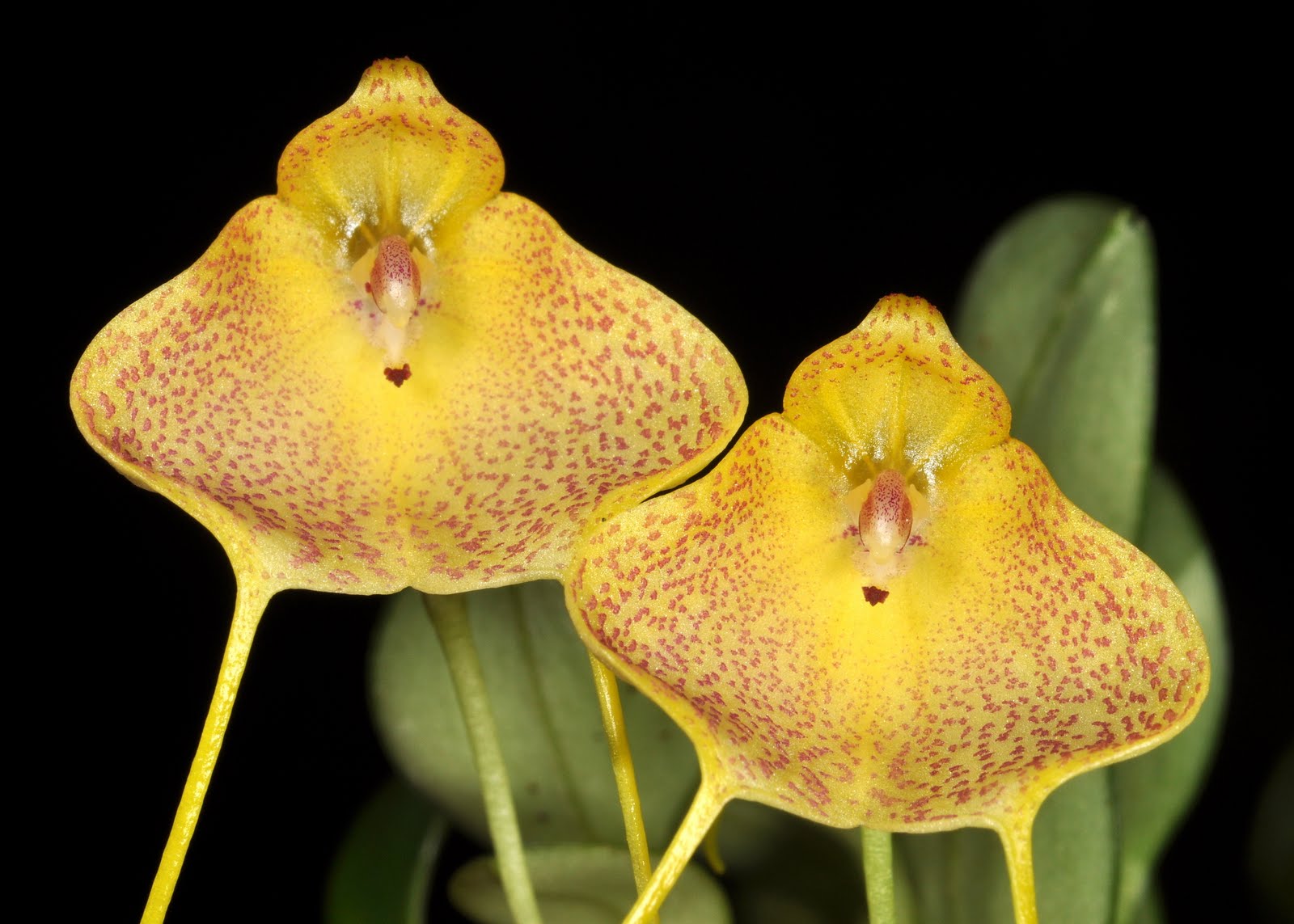
Masdevallia: Selected species and their culture Sonoma Orchid Society April Meeting Speaker, Mary Gerritsen Ph.D
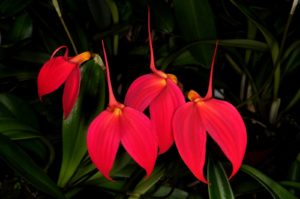
Masdevallia coccinea – J. Leathers [Photo: Ron Parsons]
Mary begins her talk with the story of writing her first orchid book.
Mary Gerritsen wrote her first orchid book, Masdevallias, Gems of the Orchid World, because she was unable to find any suitable book written about Masdevallias! She approached Timber Press and offered to write it. She already had quite an impressive resume from her medical career, authoring papers for many medical journals and also contributing to medical textbooks, but this was the first botanical book that she would attempt. After the publisher was confident she had the writing ability they agreed and let her know they had been looking for someone to write that very book. Mary then approached Ron, to co-author and the rest is history.
![Cloud forrest in northern Ecuador near the border of Peru. Home to many pleurothallids, Lepanthes, Dracula and Masdevallias including Masdevallia cucullata, Masdevallia picturata, Masdevallia ventricularia, and Masdevallia amanda. [Photo: Mary Gerritsen]](https://youplants.com/wp-content/uploads/2016/05/P1120754-300x225.jpg)
Cloud forest in northern Ecuador near the border of Columbia. Home to many Pleurothallids, Lepanthes, Dracula and Masdevallias including Masdevallia cucullata, Masdevallia picturata, Masdevallia ventricularia, and Masdevallia amanda. [Photo: Mary Gerritsen]
Mary’s Orchid field trips provide knowledge of their culture.
Mary’s vast cultural knowledge about Masdevallia care has been obtained through combining her countless observations of orchids in their natural habitat, with her trial and error growing these beautiful plants at home over the years.
First and foremost providing for the cultural requirements of Masdevallia, or any plants for that matter, is an attempt to replicate the environment that the plants would naturally experience in the wild. Masdevallias are found from Mexico to Southern Brazil at high elevations in tropical mossy cloud forests. They typically experience consistent cool and humid conditions as well as daily or nightly rainfall.
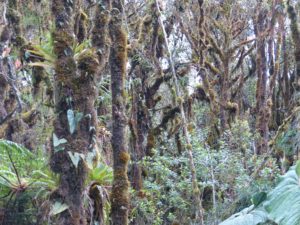
Mossy trees, Puracé National Park, Colombia. In this cloud forrest Mary found many Lepanthes, Telipogon, Platystele, Stelis and Masdevallia species including Masdevallia racemosa and Masdevallia uncifera [Photo: Mary Gerritsen]
Masdevallia culture requires cool and humid conditions
The elevation that orchids are found is usually measured meters above sea level. Although all Masdevallias are highland plants, different Masdevallia species are found at different elevations, and so will generally fall into three categories, cool-cold, intermediate, and warm growing. This correlates to the different temperatures that the plants will prefer for day and nights. As general rule all Masdevallia prefer temperature less than 80F(27C) Day and humidity of 70%+ with a nightly drop in temperature for best growth. Also to note some hybrids and species with a wider natural range will tolerate warmer, and less humid conditions much better than species that inhabit a very specific cultural niche in the wild. Refer to the table for the different categories of Masdevallias and their temperature ranges
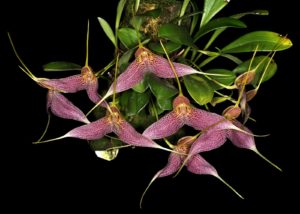
Masdevallia decumana – Grown by M. Turkel [Photo: Ron Parsons]
Day/Night Temperature Preference for Masdevallia Elevation Categories
| Day Temperature | Night Temperature | |
| Cool-Cold |
50-63F/10-17C |
45-53F/7-12C |
| Intermediate |
55-68F/13-20C |
50-56F/10-13C |
|
Warm |
68-80F/20-26C |
60-65F/16-18C. |
In order to maintain cool temperatures in the greenhouse during the heat of a summer, Mary recommends employing an overpowered swamp cooler, or wet wall which will be required to run less, helping your equipment to last longer, and ensure that you don’t overheat your plants. She also uses a humidifier in her greenhouse to make sure the humidity stays optimal, 70% or higher consistently. Again go for more humidifying ability than you require so it can run less and your unit will last longer.
Mary grows her impressive collection of Masdevallia at her home in a cool-cold lath house and cool greenhouse. The temperatures in her cool greenhouse are 74-80F(23-26C) at the warmest and lows of 50-55F(10-13C) at the coldest. The humidity is constantly over 70%. She grows some of her more cold hardy Masdevallias in the cool-cold lath house which goes down to low of 32F(0C) in the winter.
Water: PH, TDS, and light fertilizer are important in Masdevallia culture
As a result of the consistent rainfall they normally experience in nature Masdevallias are sensitive to higher amounts of minerals often found in tap and/or well water. Mary recommends that when growing these orchids you monitor TDS (Total dissolved solids) of the water you provide to your plants. Most of the time the water on tap at your house will have a TDS that is greater than >100PPM(parts per million) which is too “hard” for optimal Masdevallia culture. Do not use softened water as that often contains unsafe levels of sodium which is harmful to plants. In order to provide purified water for your plants it is advisable to either invest in a reverse osmosis(R/O) filter, which will bring your tap’s TDS close to 0ppm, or you can purchase purified water which is available at many local stores in your area. Generally the best price for purified water will be found at the grocery store where you bring and fill your own bottle.
TDS (total dissolved solids) is the measurement of the amount of nutrients in water.
- You can easily measure your TDS using a simple TDS meter, which uses electric current and is available online or locally at a variety of retailers.
- Masdevallia prefer a source of water less than <100PPM
- When watering your Masdevallias Mary recommends mixing purified (R/O or distilled)water with tap water for a final TDS of around 60ppm.(Masdevallias do appreciate the minerals found in tap water just less concentrated)
PH is a measure of the acidity of the water and ranges from 0 being most acidic and 12 being most basic.
- It’s important to know the PH the water when you are fertilizing plants because it affects the nutrients that are absorbed.
- Incorrect PH will change the PH of the medium which is detrimental over time.
- Can easily be measured with chemical test or ph meter
- Mary recommends to fertilize Masdevallia, bi-weekly with a weak (¼ strength) and prefer a slightly acidic PH between 5.5-6.0
![Masdevallia coccinea - Grown by J Leathers [Photo: Ron Parsons]](https://youplants.com/wp-content/uploads/2016/05/Masdevallia-coccinea-pink-flowers-ron-parsons-215x300.jpg)
Masdevallia coccinea – Grown by J Leathers [Photo: Ron Parsons]
Mediums Choices for Masdevallias
Mary went real quick into different potting medium choices for Masdevallias. She uses pots for most masdevallias and generally will use a mount when the flowers, or growth habit of the plant is better suited, ie plants that have spikes that flower down, would put blooms below the pot which would then be lost behind other pots, and so is better suited for displaying it’s blooms on a mount.
Mary finds a variety of mixes to work well for Masdevallias. The medium choice effects the amount of water that the pot will hold. Another major difference between the media options is the reporting schedule because each will decompose at a different rate.
Repotting Frequency for different Masdevallia mediums
| Every Year | |
| Fine Fir Bark mix | 1-2 Years |
| Mounted | Mount rots 2-4 Years |
Masdevallias: Pests and Diseases
Now that you have the basics of getting your plants environment dialed in and you have a beautiful collection of Masdevallias healthy and growing it is important to protect your plants! Mary went over a few of the common pests found in greenhouse culture and some ways to avoid infestation.
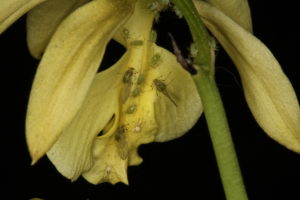
Aphids attacking an orchid. [Photo: Ron Parsons]
Some common pests found on Masdevallias include:
- Scales/Mealy Bugs-Generally spread slower and killed by most general insecticides,
- Aphids*** A major caution that she offered is for aphids. Aphids are especially devastating to Masdevallia because they can infect your plants with the fatal highly contagious yellow bean mosaic virus.***
- Spider mites- Not insects and so are not controlled with general insecticides and require specialized miticide.
- Slugs/Snails are especially problematic to smaller plants, they can eat larger portions and kill a plant overnight
***This is a devastating highly contagious disease that can quickly decimate an entire collection, so it is very important to prevent aphids to prevent the disease. In Mary’s experience a high percentage of aphids are carriers. If you think a plant is virused, (see photo) the plant should be segregated to prevent spreading the virus to other plants. If the new leaves come out misshapen the plant should be binned to prevent spreading the virus to all of your other plants.
“An ounce of prevention is worth a pound of cure” this old quote from Ben Franklin is just as applicable to garden pest control as it was to fire safety over 200 years ago!. Mary’s recommends a regular application of a few systemic insecticides to prevent aphids and other pests on your Masdevallias. She cautioned it’s important to not be afraid to use extreme measures to protect your collections at the very first signs of a problem because the pests can get out of hand quickly and decimate your entire collection.
If you are trying to eliminate an infestation it is important to repeat pesticide application again in 7-10 days. This is because eggs are usually not killed by insecticides and so the repeat application will prevent reinfestation.
Mary recommends products to prevent and control pests on Masdevallia.
- 70% isopropyl and a toothbrush is effective treatment to remove visible scales and mealybugs. (followed with two sequential systemic insecticide treatments )
- Bayer 3-1 Insect, disease, and mites (formulation FOR ornamentals NOT grass) **Mary recommends for regular preventive treatments.**
- Safari: for scale, mites, mealy, and aphids **Mary recommends for regular preventive treatments.**

Masdevallia coccinea var. xanthina – Grown by J. Leathers [Photo: Ron Parsons]
Mary’s selected species from each sub Genera of Masdevallia
The genus Masdevallia currently has over 500 different species and is still unresolved taxonomically. As more DNA research uncovers new genetic relationships, orchids are reclassified and renamed.Mary presented many species and I have selected a few highlights and some that were noted easy to care for. If you want to know more about the different varieties af Masdevallia and how to care for them I recommend Mary and Ron’s book, Masdevallias, Gems of the Orchid World .
Masdevallia coccinea
A terrestrial growing Masdevallia that appreciates high humidity and cool conditions. relatively tolerant of heat compared to other species.(Not too hot!) My personal first Masdevallia I have a few M. coccinea that bloom outside on my porch protected from hot midday sun.
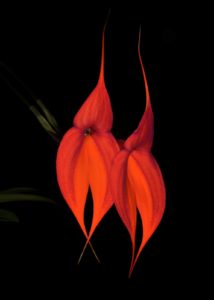
Masdevallia veitchiana – Grown by J Leathers [Photo: Ron Parsons]
Masdevallia veitchiana 2000-4000 meters above sea level
The “king of masdevallia” is a large Masdevallia found in Peru and Colombia. M. veitchiana appreciates high humidity and cool temperatures..

Masdevallia rosea with beautiful purple flowers.- Grown by Ecuaflora [Photo:Ron Parsons]
Masdevallia rosea
This is one of Mary’s personal favorite species, and not the easiest to grow, not tollerant of warmer conditions, Mary said M. rosea “demands cool temperatures.”
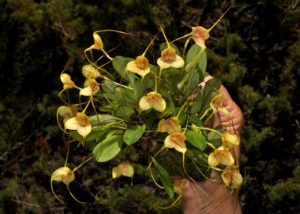
Masdevallia x wubbenii – Grown by M Gerritsen [Photo: Ron Parsons]
Masdevallia xwubbenii
A natural hybrid of M. triangularis and M. pteroglossa. Was the first Masdevallia in Mary’s collection. M xwubbenii is floriferous, robust, and easy grower that prefers cool to intermediate temperatures.

Masdevallia tonduzii – Grown by B.Cotten [Photo: Ron Parsons]
Masdevallia tonduzii
Mary found that M. tonduzii is able to tolerate higher temperatures than most Masdevallias able to withstand in the 90s(32+C) outside with good air circulation.
![Masdevallia nidifica - Grown by M Gerritsen [Photo: Ron Parsons]](https://youplants.com/wp-content/uploads/2016/05/Masdevallia-nidifica-Mary-Gerritsen-215x300.jpg)
Masdevallia nidifica – Grown by M Gerritsen [Photo: Ron Parsons]
Masdevallia nidifica
Mary recommends this species as an easier grower that tolerates a wider range of conditions.M. nidifica blooms throughout the year and multiplies fast.
I would like to thanks Ron Parson’s for permission to use his photos in this article. Ron has over 100,000 photos of orchids and other flowers. You can find more of his work on his website, flowershots.net
 Mary Gerritsen Bio from Mary Gerritsen Orchid Talks
Mary Gerritsen Bio from Mary Gerritsen Orchid Talks
Mary Gerritsen, Ph.D. is an independent biotechnology consultant who has been growing orchids (mostly species) on and off for more than 30 years, and since relocating to the San Francisco Bay area in 1997 started to amass a collection of small cool growing miniature species such as Masdevallias, Porroglossums, Lepanthes and other assorted tiny gems. She also has a second intermediate greenhouse, filled with larger species such as Angraecoids, Dendrobiums, Oncidiums, Laelias, Phalaenopsis and Bulbophyllums. She loves to see orchids growing in situ, and has made it her mission over the last few years to see as many as possible, with trips to see and photograph orchids (and other flora as well) in Canada, various states in the USA, Mexico, Ecuador, Peru, Costa Rica, Panamá, Brazil, China, Germany, Rhodes and Crete, Australia and most recently, Borneo. She is the co-author of three botanical books: Masdevallias, Gems of the Orchid World, and Calochortus, Mariposa Lilies and their Relatives, and A Compendium of Miniature Orchid Species Volume 1 & Volume 2with fellow San Francisco Orchid Society Member and well known photographer, Ron Parsons.In addition to being a member of the San Franciso Orchid Society, and the Pleurothallid Alliance, Mary has served as the vice president and president of the Peninsula Orchid Society (San Mateo). She is currently the vice-president of the San Francisco Orchid Society . ~Bio information from Mary Gerritsen Orchid Talks
One Comment
Hope you find this information useful, I would love to here from you, please comment below with any questions or comments!
![Mary's cool greenhouse where she grows many Masdevallia species [Photo: Mary Gerritsen]](https://youplants.com/wp-content/uploads/2016/05/Orchid-growing-in-Marys-cool-greenhouse-300x154.png)
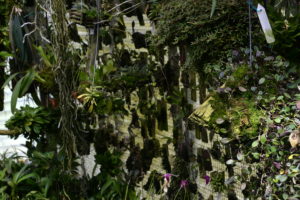


![Yellow bean mosaic virused orchid [Photo: Mary Gerritsen]](https://youplants.com/wp-content/uploads/2016/05/Yellow-bean-mosaic-virus-damage-on-an-orchid-300x200.jpg)
![Masdevallia coccinea 'chris' Blooming on my porch in Santa Rosa CA [Photo: April 26, 2016]](https://youplants.com/wp-content/uploads/2016/05/Masdevallia-coccinea-chris-April-26-2016--225x300.jpg)

Recent Comments